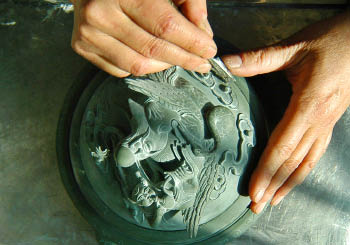|
By staff reporter XING WEN

INKSTONE, along with ink, writing brush and rice paper, are known as the Four Treasures of Study in China.
For calligraphers and painters, a good inkstone is as important as the inkstick itself. An inkstone is a slate to grind the solid inkstick in water, and as such may greatly effect the quality of the liquid ink.
The functions of an inkstone are much more than its role as a grindstone. It is a piece of art that reflects historical and cultural elements. Moreover, the beauty of an inkstone not only depends on its texture, color or the thing it is shaped to resemble, but much more on its capacity to integrate with ink and brush. A good inkstone produces smooth and thick liquid ink while doing no harm to the brush.
Formed from primitive grindstones, the first inkstone appeared during the Han Dynasty (206 B.C.-A.D. 220) and the tool reached the peak of its popularity during the Tang (618-907) and Song (960-1279) dynasties.
The stone tablet in all its guises has a round, square or oblong flat-bottomed indentation for grinding. Ancient people sometimes engraved their names or mottos on the surface of inkstones and passed this Treasure of Study onto later generations.
A variety of ink grinders are still produced all over China, but the best known of them are Duan, She, Tao and Chengni inkstones.
Selecting the most appropriate material is the key to making a high-quality inkstone. Some kinds of stones produce too much residue in the bottom when ink bars are ground there, while some other kinds absorb the ink quickly. Therefore, craftsmen must test for hardness and density when selecting a piece of usable stone. Those buried underground for thousands of years are the most ideal of materials.
After the proper material is selected, an inkstone maker carefully observes the stone's shape, structure and texture. Forming a design in his mind, the maker then draws patterns on the stone and sculpts it. Every step is done by hand and each inkstone therefore is different from all others as each craftsman brings his own aesthetics and individual skills to the task.
She Inkstones
She inkstones are named after their birthplace in today's Shexian, Anhui Province. Longwei Mountain in the region harbors supreme-quality rocks. She inkstones were first made in the Han Dynasty and became famous in the Tang Dynasty. Emperors even ordered workshops set up and appointed craftsmen to supervise inkstone production in the area.
Because She inkstones are usually made of the densest stone, their texture is smooth and lustrous. In Chinese ink paintings, artists create a variety of hues by balancing the ratio of ink and water. She inkstones were preferred for their exceptional ability to hold moisture.
The raw materials for She inkstones are selected from rocks formed some hundred thousand years ago. During millennia of geological change, some deposits naturally developed a variety of textures and hues that lend themselves to artistic interpretations. The slate used for a She inkstone usually carries glittering golden or silver speckles, veins, stripes or waves that assume different patterns. The ones dotted with "golden stars" or jade veins are rare, and therefore the most valuable.
| 
